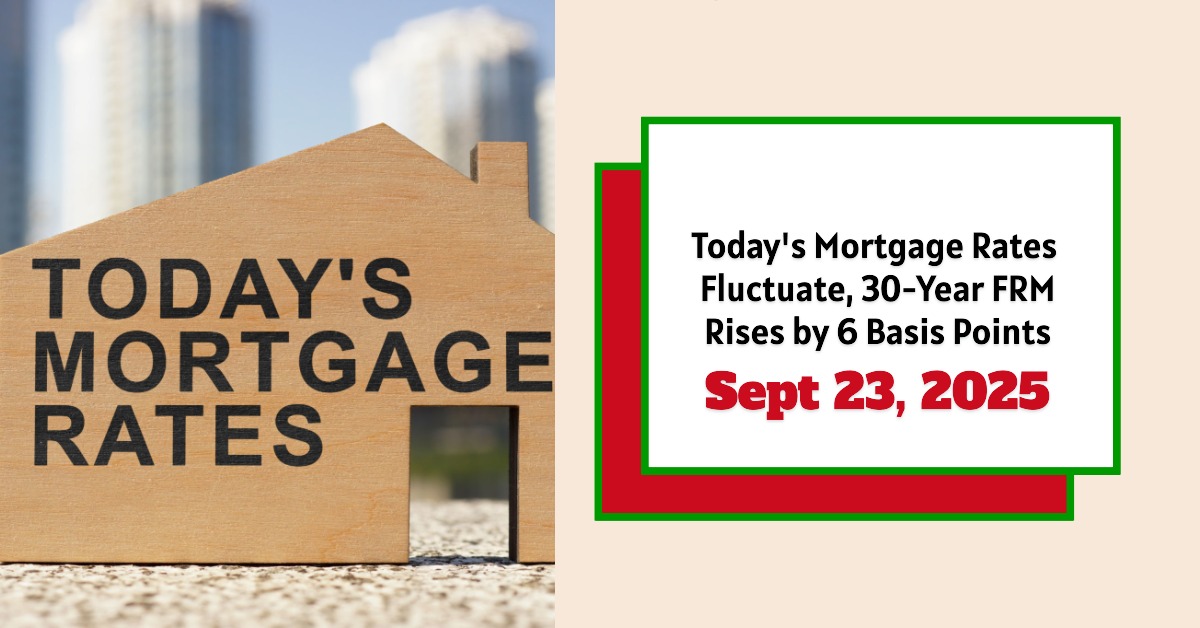As of September 23, 2025, mortgage rates have shown mixed movement with the average 30-year fixed mortgage rate slightly dropping to 6.53% after a recent rise, while refinance rates also saw a modest dip with the 30-year fixed refinance rate dropping to 6.91%. Despite the Federal Reserve’s recent quarter-point rate cut aimed at easing borrowing costs, long-term mortgage rates remained somewhat resistant due to factors like persistent inflation fears and rising Treasury yields.
Today's Mortgage Rates – September 23, 2025: Rates Fluctuate, 30-Year FRM Rises by 6 Basis Points
Key Takeaways
- 30-year fixed mortgage rate stands at 6.53%, a small drop from 6.55% but still 6 basis points higher than last week.
- 15-year fixed mortgage rates rose to 5.86%, up 9 basis points from the previous week.
- 5-year ARM mortgage rates climbed slightly to 7.19%.
- Average 30-year fixed refinance rate dropped to 6.91%, down 15 basis points from last week.
- Federal Reserve lowered its benchmark interest rate to 4.0%-4.25%, first cut in 2025, but mortgage rates are more influenced by Treasury yields than Fed rates.
- Inflation concerns and market reactions to Fed communications keep long-term mortgage rates elevated.
- The 10-year Treasury yield stands at 4.137%, slightly below its long-term average of 4.25%, affecting mortgage rate trends.
Understanding Current Mortgage Rates and Why They Matter
Mortgage rates today reflect a complex dance between government policy, inflation expectations, and market psychology. While the Federal Reserve’s recent rate cut intended to spur economic growth by lowering short-term borrowing costs, mortgage rates don’t directly follow these cuts. Instead, they are more closely tied to the yield on the 10-year U.S. Treasury bond, which investors watch as a barometer for broader economic health and inflation expectations.
The Treasury yield has hovered around 4.137%, which is below its long-term average, implying some investor confidence but still a cautious outlook. When Treasury yields rise, mortgage rates often rise too, explaining why mortgage rates increased after the Fed cut rather than dropping as some expected.
Inflation remains a sticking point. If investors worry that cutting rates now will push prices higher, they demand higher returns on bonds to offset inflation risk, which in turn keeps mortgage rates elevated. This uncertainty means rates remain fluctuating within a narrow but relatively high range.
Current Mortgage Rates by Loan Type
Below is a detailed breakdown of average mortgage rates as of September 23, 2025, including changes from the previous week.
| Loan Type | Current Rate | Weekly Change | APR | APR Change |
|---|---|---|---|---|
| 30-Year Fixed Rate | 6.53% | +0.06% | 6.98% | +0.07% |
| 20-Year Fixed Rate | 6.29% | +0.22% | 6.56% | +0.07% |
| 15-Year Fixed Rate | 5.86% | +0.21% | 6.16% | +0.22% |
| 10-Year Fixed Rate | 5.84% | 0.00% | 6.23% | 0.00% |
| 7-Year ARM | 7.40% | +0.25% | 7.85% | -0.06% |
| 5-Year ARM | 7.19% | -0.05% | 7.95% | +0.09% |
| 30-Year Fixed FHA Loan | 7.25% | +1.56% | 8.30% | +1.60% |
| 30-Year Fixed VA Loan | 6.06% | +0.09% | 6.27% | +0.13% |
| 15-Year Fixed FHA Loan | 5.24% | -0.04% | 6.20% | -0.04% |
| 15-Year Fixed VA Loan | 5.66% | -0.02% | 6.01% | +0.05% |
Current Refinance Rates
Refinancing rates have also seen some movement this week:
| Loan Type | Current Rate | Weekly Change | APR | APR Change |
|---|---|---|---|---|
| 30-Year Fixed Refinance | 6.91% | -0.15% | — | — |
| 15-Year Fixed Refinance | 5.89% | +0.18% | — | — |
| 5-Year ARM Refinance | 7.29% | +0.11% | — | — |
While the 30-year fixed refinance average rate dropped to 6.91%, the 15-year fixed refinance rate rose by 18 basis points to 5.89%, and the 5-year ARM refinance rate slightly increased to 7.29%. This divergence shows that refinancing options vary depending on loan type and investor appetite.
Why Are Mortgage Rates Not Dropping More Despite Fed Cuts?
Many people expect mortgage rates to fall in lockstep with Federal Reserve cuts, but that’s not how the market functions. The Fed influences short-term interest rates but mortgage rates are tied to long-term bond yields.
After the Fed's 0.25% cut on September 17, 2025, the long-term yields spiked rather than dropped because:
- Investors reassessed inflation risks.
- The Fed’s rate cut was smaller than some anticipated.
- Market expectations shifted, focusing on future inflation and Fed policy rather than the immediate cut.
- The 10-year Treasury bond yield increased temporarily, pushing mortgage rates up despite Fed cuts.
This dynamic shows that mortgage rates reflect broader economic realities, not a simple response to Fed actions alone.
Example Calculation: How Interest Rate Changes Impact Monthly Payments
For a home loan of $300,000, the difference of even a fraction of one percent in interest rates can affect monthly payment amounts.
| Interest Rate | Monthly Principal & Interest Payment |
|---|---|
| 6.53% | $1,898 |
| 6.47% | $1,891 |
| 6.29% | $1,872 |
Calculation based on a 30-year fixed loan using the standard mortgage formula.
This means a 0.24% increase in rate (from 6.29% to 6.53%) results in about $26 higher monthly payments. While that may seem modest, it adds up over the life of the mortgage.
The Federal Reserve’s Role and the Economic Context
The Fed cut its benchmark interest rate to 4.0%-4.25% as a precautionary move to support a mildly slowing economy. This “risk-management” decision reflects concern over slowing job growth and ongoing inflation near 3%, above the Fed’s 2% target.
Chair Jerome Powell emphasized balancing these risks, as the labor market began showing signs of softening, evidenced by an increased unemployment rate of 4.3% in August 2025. The Fed’s focus is on stabilizing the economy without triggering excessive inflation or recession. However, mortgage rates depend largely on how investors view future inflation and growth, thus keeping them relatively high.
Forecast for Mortgage Rates: Will They Rise or Fall?
Several leading organizations have provided their outlook:
- National Association of REALTORS®: Expects mortgage rates to average 6.4% in late 2025 and drop to about 6.1% in 2026, improving buyer affordability.
- Fannie Mae: Projects mortgage rates ending 2025 around 6.5%, with a modest dip to 6.1% in 2026.
- Mortgage Bankers Association: Foresees a 30-year fixed mortgage rate near 6.7% by year-end 2025, easing to 6.5% by end of 2026 amid volatility in the mortgage-Treasury spread.
The current mild decline in mortgage rates and Treasury yields points to a cautious but potentially favorable environment for borrowers, especially if inflation calms and the Fed continues only measured rate cuts.
Related Topics:
Mortgage Rates Trends as of September 22, 2025
Mortgage Rates Predictions Next 90 Days: August to October 2025
What This Means for Borrowers and the Housing Market
- Homebuyers get slightly better affordability when mortgage rates stabilize or decline.
- Refinancers can capitalize on drops in refinance rates, especially if they locked in higher rates earlier.
- Sellers may see increased purchase activity if buyers find improved financing.
- However, home prices remain elevated, so the net benefit depends on market conditions and personal circumstances.
Summary Table: Today’s Mortgage and Refinance Rates at a Glance
| Loan Type | Rate (%) | Change from Last Week |
|---|---|---|
| 30-Year Fixed Mortgage | 6.53 | +0.06% |
| 15-Year Fixed Mortgage | 5.86 | +0.09% |
| 5-Year ARM Mortgage | 7.19 | +0.09% |
| 30-Year Fixed Refinance | 6.91 | -0.15% |
| 15-Year Fixed Refinance | 5.89 | +0.18% |
| 5-Year ARM Refinance | 7.29 | +0.11% |
Mortgage rates today, September 23, 2025, reflect a nuanced picture. They remain relatively high compared to historical lows but have shown small declines after the Federal Reserve’s recent rate cut. For those considering a mortgage or refinance, understanding how factors like Treasury yields, inflation, and Fed policy influence today's rates is key to making informed decisions.
Capitalize Amid Rising Mortgage Rates
With mortgage rates expected to remain high in 2025, it’s more important than ever to focus on strategic real estate investments that offer stability and passive income.
Norada delivers turnkey rental properties in resilient markets—helping you build steady cash flow and protect your wealth from borrowing cost volatility.
HOT NEW LISTINGS JUST ADDED!
Speak with a seasoned Norada investment counselor today (No Obligation):
(800) 611‑3060
Also Read:
- Will Mortgage Rates Go Down in 2025: Morgan Stanley's Forecast
- Mortgage Rate Predictions 2025 from 4 Leading Housing Experts
- Mortgage Rate Predictions for the Next 3 Years: 2026, 2027, 2028
- 30-Year Fixed Mortgage Rate Forecast for the Next 5 Years
- 15-Year Fixed Mortgage Rate Predictions for Next 5 Years: 2025-2029
- Will Mortgage Rates Ever Be 3% Again in the Future?
- Mortgage Rates Predictions for Next 2 Years
- Mortgage Rate Predictions for Next 5 Years
- Mortgage Rate Predictions: Why 2% and 3% Rates are Out of Reach
- How Lower Mortgage Rates Can Save You Thousands?
- How to Get a Low Mortgage Interest Rate?
- Will Mortgage Rates Ever Be 4% Again?



